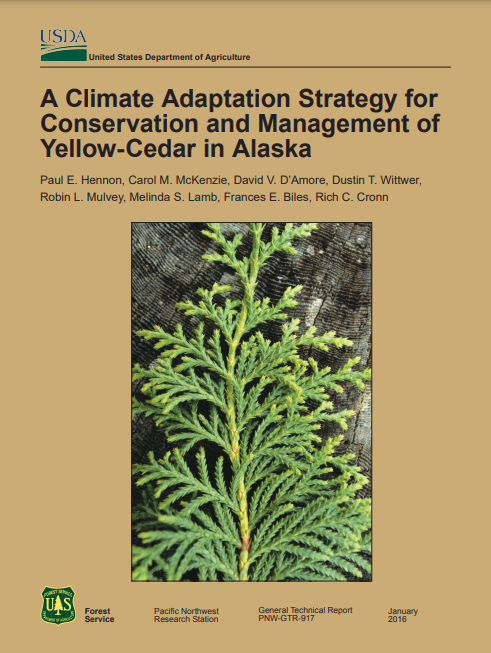Article /
A Climate Adaptation Strategy for Conservation and Management of Yellowcedar in Alaska

Summary
This resource was submitted by the Climate Risk Institute for use by the CanAdapt Climate Change Adaptation Community of Practice.
This article is an abridged version of the original text, which can be downloaded from the right-hand column. Please access the original text for more detail, research purposes, full references, or to quote text.
In 2011, the Alaska Region of the U.S. Department of Agriculture, Forest Service identified the need to develop a conservation and management strategy for yellowcedar. Forest Service specialists would synthesize what was known about the species in terms of best available science, evaluate the current and future condition and vulnerability of the species, and recommend conservation and management strategies that would address these vulnerabilities. This report is the product of a collaborative team: Alaska Region land managers and specialists, State and Private Forestry forest health professionals, and Pacific Northwest Research Station scientists.
The report contains four sections and four appendixes. Section 1 provides background on the values, distribution, natural history, ecology, genetics, silvics, and management experience for yellow-cedar to serve as a general reference for the species. Section 2 describes the extent and causes of the widespread decline and mortality of yellow-cedar, with emphasis on the historical and anticipated role of climate. Section 3 offers management considerations on lands in protection and active management status that have current mortality (e.g., succession to other tree species and salvage potential) or in areas of current and future favorable habitat (e.g., favoring yellow-cedar through active management such as planting and thinning). Section 4 quantifies and maps the risk of yellow-cedar decline through time as the basis for determining yellow-cedar habitat suitability. The complex cause of yellow-cedar decline is reduced to two risk factors (drainage and snow) that are used to model habitat suitability for yellow-cedar forests in Alaska. Snow is a dynamic risk factor and it is modeled in three time steps to predict future conditions in yellow-cedar forests. Models suggest that risk to yellow-cedar decline in Alaska by the end of the century varies considerably by geography and elevation with some forests already affected, some forests expected to develop mortality, and still others expected to remain healthy.
Appendix 1 provides a detailed risk assessment for 33 geographic units in coastal Alaska on the extent of (a) yellow-cedar populations, (b) forests with current and expected future mortality, and (c) current and expected future risk of yellowcedar decline. Appendix 2 summarizes information gaps and research needs. Appendix 3 documents known young-growth stands on Tongass National Forest land with a yellow-cedar component. Last, appendix 4 lists common and scientific names of plants, mammals, insects, and fungi mentioned in the report. This document may serve as a scientific foundation for developing adaptation strategies in other forests affected by climate change.
Citations: Hennon, Paul E.; McKenzie, Carol M.; D’Amore, David V.; Wittwer, Dustin
T.; Mulvey, Robin L.; Lamb, Melinda S.; Biles, Frances E.; Cronn, Rich C.
2016. A climate adaptation strategy for conservation and management of yellowcedar
in Alaska. Gen. Tech. Rep. PNW-GTR-917. Portland, OR: U.S. Department
of Agriculture, Forest Service, Pacific Northwest Research Station. 382 p.
- Provisional tree seed zones and transfer guidelines for Alaska
- Influence of elevation and site productivity on conifer distributions across Alaskan temperate rainforests
